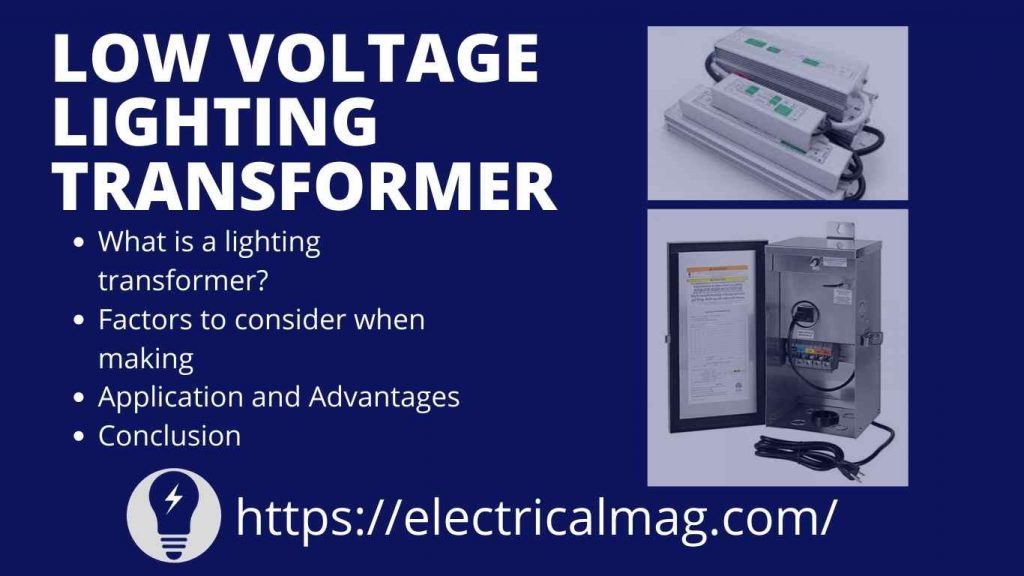Introduction
Electrical lighting devices are the single most numerous among all electrical loads. In an average home there no less than five pieces of lighting. In 1880 Thomas Edson invented electrical lighting and was the only electrical device since the world has seen an influx of lighting everywhere inhabited by man. It’s worth noting there has been great advancement in light bulbs from incandescent to fluorescent and lighting emitting diodes. As this technology advances, there are two types of bulbs, the one that operates at supply line voltage and the one that requires a much lower voltage. In an earlier post, we learned about the transformer’s main function as voltage steppers. Today we would look at this special transformer used to step down the voltage to match the rating of the bulb.

What is a lighting transformer?
Most incandescent and florescent bulbs are usually made to operate at line voltage-from the power distribution company. There is however light-emitting diode type of bulb that cannot operate at a supply voltage as it is too high (can burn the diode). A low voltage lighting transformer is an electrical device that steps down line voltage to a lower voltage required by the lighting bulb. The diode requires about 5 Voltages to light, to lower the line voltage a small transformer is used to step down voltage. The typical output voltage of is 12-15V which is further stepped down by electronic components such as resistors to achieve the voltage required by these diodes.
Companies producing low voltage bulb may manufacture and integrate this transformer into a single unit that have its terminal ready to be connection to line voltage for it work. This is not advisable as failure of either the bulb or the transformer render the device unserviceable. To overcome this, most manufactures are producing bulbs and transformers as different units, the market name for the transformer in power supply adapter or drive. The step-down transformer is usually mounted on a printed circuit board along with other electronic accessories.
Factors to consider when making or buying one
The following are the points to consider when acquiring one.
- Voltage rating- get to know the voltage supplied to where to need the light and as well the voltage input of the light bulb you want to install. This will give you the input and output rating you need.
- Wattage – calculate the total power consumption of your bulbs. Multiply the power rating of each identical unit by the number of units and for different rates ones, simply add up. Make an allowance of 20% more power for the transformer to ensure it not working at the maxima and possible addition of one or two bulbs in the future.
- Core type- the quality of a transformer depends on winding wires and the core. Toroidal type is less noisy and durable, the magnetic core is cheap but noisy while the electronic core is expensive, less durable but small in size and weight.
- Enclosure – the place where you are installing will determine the enclosure to go for. Would it brace the weather conditions? The types may vary from open, plastic, or metallic. For outdoor usage, ensure it is waterproof, harsh weatherproof while at the same time allow cooling.
Application and Advantages
As the need arises, these transformers are also embedded with electronic sensors for automatic operate of light. Some of these include photocell that light up the bulb at dust and off at dawn; motion sensor that light up when warm blooded living thing passes nearby and turns of when out of vicinity and timer clock that is programmable as per when the user wants the light to turn on or off.
The demand for these devices will be as high as there are low voltage bulbs there that are produced in their thousands every single day. As the world turns on light-emitting diodes
- Less electricity bill and less frequency of replacing bulbs is realized
- Reduce global warming as fewer petroleum products are burnt for electricity
- They come in different colors of light output that gives an aesthetic appeal to homes, entertainment joints, city beautification, and social events decoration.
- Security and safety of our environment as lighting will be affordable and available.
Conclusion
The output voltage of this transformer is quite low and safer to work around within a live circuit compared to line voltage. Servicing of the lamps can there be carried out without necessarily switching the lights at the supply point. It’s no doubt that this device will be required and used more and more as time goes by. Remember to get this right: voltage and power rating, type of core, and the type of enclosure. Word of caution; engage a qualified and licensed electrician in any electrical work as electricity can kill you when mishandled.
